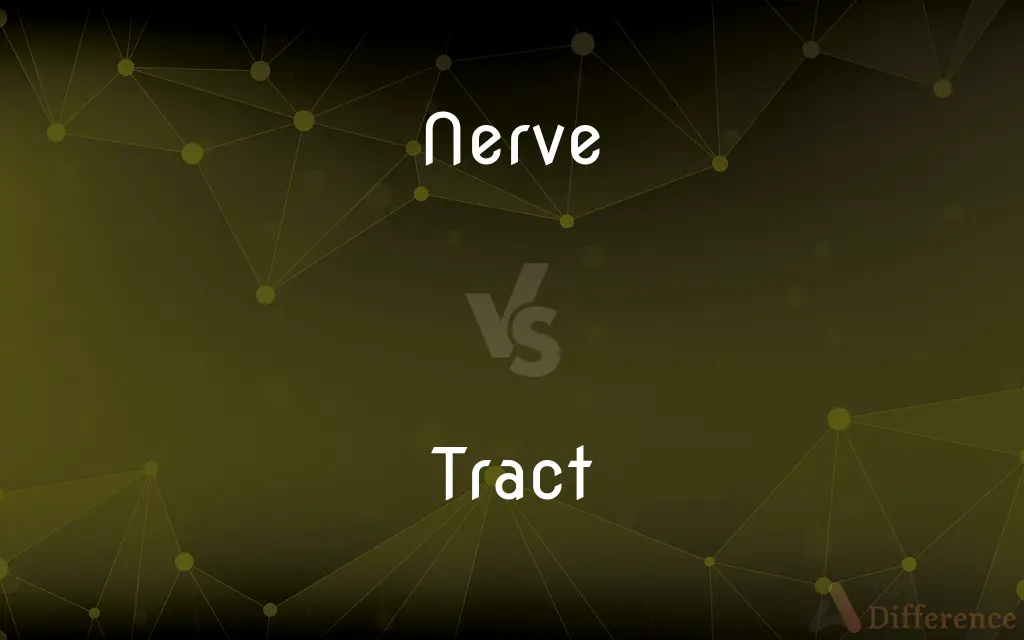Nerve vs. Tract — What's the Difference?
By Tayyaba Rehman & Maham Liaqat — Updated on April 5, 2024
Nerve is a bundle of neuronal axons outside the central nervous system, transmitting signals to and from the body and brain, while tract is a collection of axons within the central nervous system, facilitating communication between different brain areas.

Difference Between Nerve and Tract
Table of Contents
ADVERTISEMENT
Key Differences
A nerve consists of numerous axons (nerve fibers) bundled together, often encased in a myelin sheath, which facilitates the fast transmission of electrical signals between the brain and various parts of the body. These structures are crucial for sensory information delivery to the brain and motor command delivery from the brain. On the other hand, a tract is a bundle of axons located within the central nervous system (CNS), which includes the brain and spinal cord. Tracts are responsible for transmitting signals between different CNS regions, playing a key role in integrating sensory and motor functions.
Nerves are classified as part of the peripheral nervous system (PNS), extending from the CNS to limbs and organs. They are the communication lines that carry signals related to senses, pain, and motor commands. Whereas tracts, being part of the CNS, are involved in processing and relaying these signals within the brain and spinal cord, ensuring that the body responds appropriately to sensory inputs and brain commands.
The structure of nerves includes not only axons but also connective tissue and blood vessels, providing support and nourishment. Each nerve is like a cable containing many individual wires (axons), each transmitting different types of signals. In contrast, tracts are more like highways within the brain and spinal cord, with axons grouped together based on the type of information they carry or their destination, but without the additional supportive tissue found in nerves.
The functionality of nerves is often categorized into three types: sensory (afferent), motor (efferent), or mixed, indicating the direction of signal transmission. Sensory nerves carry information from the sensory receptors to the CNS, motor nerves convey commands from the CNS to muscles, and mixed nerves do both. Tracts, however, are primarily defined by the direction of signal transmission (ascending for sensory inputs to the brain, and descending for motor outputs from the brain) and their location within the CNS.
One of the key differences in damage and disease impact is how nerves and tracts affect the body. Damage to a nerve can lead to loss of sensation or movement in a specific body part, depending on the nerve’s role. Conversely, damage to a tract within the CNS can result in more widespread or systemic impairments, such as paralysis or loss of sensation, affecting larger areas of the body or multiple functions due to the tract’s integral role in CNS communication.
ADVERTISEMENT
Comparison Chart
Location
Outside the central nervous system (CNS)
Within the central nervous system (CNS)
Function
Transmit signals to and from the brain and body parts
Facilitate communication between different brain areas
Composition
Axons, connective tissue, blood vessels
Axons (often myelinated) without additional supportive tissues
System
Part of the peripheral nervous system (PNS)
Part of the CNS
Types/Classification
Sensory, motor, mixed based on signal direction
Ascending, descending based on signal direction and location within the CNS
Compare with Definitions
Nerve
A bundle of axons in the peripheral nervous system transmitting signals.
The sciatic nerve runs from the lower back down to the legs.
Tract
A collection of axons in the brain or spinal cord with a common origin and destination.
The optic tract carries visual information from the eyes to the brain.
Nerve
The physical pathway for electrical impulses in the body.
Nerve damage in the hand can affect its movement and sensation.
Tract
A bundle of nerve fibers within the CNS.
The spinal tract transmits information from the body to the brain.
Nerve
An organ consisting of fibers conveying impulses.
The optic nerve provides the brain with visual information.
Tract
Pathways that facilitate communication in the brain and spinal cord.
Damage to a motor tract can impair movement.
Nerve
The structure responsible for sensory and motor function in the peripheral body.
Sensory nerves alert the brain to temperature changes.
Tract
Integral for the internal processing and relay of signals.
Ascending tracts send sensory information to the brain.
Nerve
A critical component in the communication between the brain and limbs.
Nerves control muscle movements through electrical signals.
Tract
Structures that organize CNS communication.
Descending tracts are involved in the control of motor functions.
Nerve
A nerve is an enclosed, cable-like bundle of fibers (called axons) in the peripheral nervous system. A nerve transmits electrical impulses.
Tract
An expanse of land or water.
Nerve
Any of the cordlike bundles of fibers made up of neurons through which sensory stimuli and motor impulses pass between the brain or other parts of the central nervous system and the eyes, glands, muscles, and other parts of the body. Nerves form a network of pathways for conducting information throughout the body.
Tract
A specified or limited area of land
Developing a 30-acre tract.
Nerve
The sensitive tissue in the pulp of a tooth.
Tract
A system of organs and tissues that together perform a specialized function
The alimentary tract.
Nerve
A sore point or sensitive subject
The criticism touched a nerve.
Tract
A bundle of nerve fibers having a common origin, termination, and function.
Nerve
Courage and control under pressure
Lost his nerve at the last minute.
Tract
(Archaic) A stretch or lapse of time.
Nerve
Fortitude; stamina.
Tract
A leaflet or pamphlet containing a declaration or appeal, especially one put out by a religious or political group.
Nerve
Forceful quality; boldness.
Tract
The verses from Scripture sung after the gradual in the Roman Catholic Mass during penitential seasons such as Lent or as part of a Requiem.
Nerve
Brazen boldness; effrontery
Had the nerve to deny it.
Tract
An area or expanse.
An unexplored tract of sea
Nerve
Nerves Nervous agitation caused by fear, anxiety, or stress
Had a sudden attack of nerves.
Tract
(anatomy) A series of connected body organs, such as the digestive tract.
Nerve
A vein or rib in the wing of an insect.
Tract
A small booklet such as a pamphlet, often for promotional or informational uses.
Nerve
The midrib and larger veins in a leaf.
Tract
A brief treatise or discourse on a subject.
Nerve
To give strength or courage to.
Tract
A commentator's view or perspective on a subject.
Nerve
A neuron.
Tract
Continued or protracted duration, length, extent
Nerve
(botany) A vein in a leaf; a grain in wood.
Some plants have ornamental value because of their contrasting nerves.
Tract
(Roman Catholicism) Part of the proper of the liturgical celebration of the Eucharist for many Christian denominations, used instead of the alleluia during Lenten or pre-Lenten seasons, in a Requiem Mass, and on a few other penitential occasions.
Nerve
Courage; boldness; audacity; gall.
He had the nerve to enter my house uninvited.
He hasn't the nerve to tell her he likes her.
Tract
(obsolete) Continuity or extension of anything.
Nerve
Patience; stamina; endurance, fortitude.
The web-team found git-sed is really a time and nerve saver when doing mass changes on your repositories
Tract
(obsolete) Traits; features; lineaments.
Nerve
(in the plural) One's neural structures considered collectively as, and conceptually equated with, one's psyche;
All these rationalizations for asinine behavior are getting on my nerves.
His nerves could no longer handle the worry.
Tract
(obsolete) The footprint of a wild animal.
Nerve
(in the plural) mental agitation caused by fear, stress or other negative emotions.
Ellie had a bad case of nerves before the big test; she was a bundle of nerves.
Tract
(obsolete) Track; trace.
Nerve
(polymer technology) The elastic resistance of raw rubber or other polymers to permanent deformation during processing.
A nervy tank lining will be difficult to lay around tight bends or in corners because it tends to spring back.Blair Rubber company glossary of terms. [https://blairrubber.com/wp-content/uploads/glossary-of-terms.pdf]
Tract
(obsolete) Treatment; exposition.
Nerve
(obsolete) Sinew, tendon.
Tract
(obsolete) To pursue, follow; to track.
Nerve
(transitive) To give courage.
May their example nerve us to face the enemy.
Tract
(obsolete) To draw out; to protract.
Nerve
(transitive) To give strength; to supply energy or vigour.
The liquor nerved up several of the men after their icy march.
Tract
A written discourse or dissertation, generally of short extent; a short treatise, especially on practical religion.
The church clergy at that time writ the best collection of tracts against popery that ever appeared.
Nerve
One of the whitish and elastic bundles of fibers, with the accompanying tissues, which transmit nervous impulses between nerve centers and various parts of the animal body.
Tract
Something drawn out or extended; expanse.
Nerve
A sinew or a tendon.
Tract
A region or quantity of land or water, of indefinite extent; an area; as, an unexplored tract of sea.
A very high mountain joined to the mainland by a narrow tract of earth.
Nerve
Physical force or steadiness; muscular power and control; constitutional vigor.
He led me on to mightiest deeds,Above the nerve of mortal arm.
Tract
Traits; features; lineaments.
The discovery of a man's self by the tracts of his countenance is a great weakness.
Nerve
Steadiness and firmness of mind; self-command in personal danger, or under suffering; unshaken courage and endurance; coolness; pluck; resolution.
Tract
The footprint of a wild beast.
Nerve
Audacity; assurance.
Tract
Track; trace.
Efface all tract of its traduction.
But flies an eagle flight, bold, and forthon,Leaving no tract behind.
Nerve
One of the principal fibrovascular bundles or ribs of a leaf, especially when these extend straight from the base or the midrib of the leaf.
Tract
Treatment; exposition.
Nerve
One of the nervures, or veins, in the wings of insects.
Tract
Continuity or extension of anything; as, the tract of speech.
Nerve
To give strength or vigor to; to supply with force; as, fear nerved his arm.
Tract
Continued or protracted duration; length; extent.
Nerve
Any bundle of nerve fibers running to various organs and tissues of the body
Tract
Verses of Scripture sung at Mass, instead of the Alleluia, from Septuagesima Sunday till the Saturday befor Easter; - so called because sung tractim, or without a break, by one voice, instead of by many as in the antiphons.
Nerve
The courage to carry on;
He kept fighting on pure spunk
You haven't got the heart for baseball
Tract
To trace out; to track; also, to draw out; to protact.
Nerve
Impudent aggressiveness;
I couldn't believe her boldness
He had the effrontery to question my honesty
Tract
An extended area of land
Nerve
Get ready for something difficult or unpleasant
Tract
A system of body parts that together serve some particular purpose
Tract
A brief treatise on a subject of interest; published in the form of a booklet
Tract
A bundle of mylenated nerve fibers following a path through the brain
Common Curiosities
What are ascending and descending tracts?
Ascending tracts carry sensory information to the brain, while descending tracts convey motor commands from the brain to the body.
How does a tract differ from a nerve?
Tracts are bundles of axons within the CNS responsible for transmitting signals between different brain areas, unlike nerves, which operate in the PNS.
Can nerves regenerate after damage?
Some nerves, especially in the PNS, have a limited ability to regenerate after damage, depending on the extent and location of the injury.
How are tracts named in the CNS?
Tracts are often named based on their location and the direction of signal transmission, such as the corticospinal tract for motor signals from the cerebral cortex to the spinal cord.
Are all nerves myelinated?
Not all nerves are myelinated; some, especially those that transmit slow, chronic pain signals, lack myelin sheaths.
What is the main function of a nerve?
Nerves transmit electrical signals between the brain and the rest of the body, facilitating sensory and motor functions.
What causes nerve pain?
Nerve pain, or neuropathy, can be caused by damage, irritation, or disease affecting nerves, disrupting signal transmission.
Can diseases affect both nerves and tracts?
Yes, diseases like multiple sclerosis can affect both nerves and tracts by damaging myelin sheaths, impairing signal transmission.
How are nerves protected in the body?
Nerves are protected by connective tissue coverings, and some are insulated by myelin sheaths to enhance signal transmission speed.
Why are CNS tracts more vulnerable to lasting damage?
CNS tracts are more vulnerable due to the limited regenerative capabilities of the CNS and the critical roles these tracts play in bodily functions.
What diagnostic methods are used to assess nerve damage?
Diagnostic methods include nerve conduction studies, electromyography (EMG), and imaging techniques like MRI.
What role do tracts play in reflex actions?
Some tracts, particularly in the spinal cord, are involved in reflex actions by transmitting signals directly between sensory inputs and motor outputs without brain intervention.
Is there a difference in the way nerves and tracts repair after injury?
Nerves in the PNS have some capacity for repair and regeneration, whereas tracts in the CNS have a limited ability to regenerate, making CNS injuries more challenging to recover from.
What are the symptoms of tract damage?
Symptoms of tract damage can include loss of sensation, paralysis, or other motor and sensory impairments, depending on the tract affected.
Can lifestyle factors affect nerve health?
Yes, factors such as diet, exercise, and avoiding excessive alcohol or toxins can significantly impact nerve health and function.
Share Your Discovery

Previous Comparison
Brilliant vs. Excellent
Next Comparison
Pistol vs. GunAuthor Spotlight
Written by
Tayyaba RehmanTayyaba Rehman is a distinguished writer, currently serving as a primary contributor to askdifference.com. As a researcher in semantics and etymology, Tayyaba's passion for the complexity of languages and their distinctions has found a perfect home on the platform. Tayyaba delves into the intricacies of language, distinguishing between commonly confused words and phrases, thereby providing clarity for readers worldwide.
Co-written by
Maham Liaqat















































